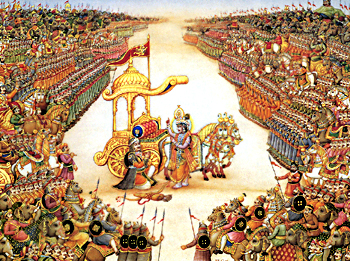 Development of Indian Army is a combination of several changes and improvements that have taken place through the ages. The epic history of Indian Army dates back to more than ten thousand years. The two epics - Ramayana and Mahabharata constitute the fundamental framework around which the structure of Indian Army has been built. The massive epic war Mahabharata, fought at Kurukshetra in north-central India, has left indelible imprints on the Indian psyche. Though innumerable wars have been fought thenceforth, almost all were in quest of universal peace and Dharma. Recourse to arms was only taken when peace was threatened. With many recent landmark findings refuting the invasion of Asian-European people, or the Aryans, into the Indian sub continent en masse, the military history of India dates back to 6th century BC. The `Arthashastra` is one of the most significant documents of military history ever to be written.
Development of Indian Army is a combination of several changes and improvements that have taken place through the ages. The epic history of Indian Army dates back to more than ten thousand years. The two epics - Ramayana and Mahabharata constitute the fundamental framework around which the structure of Indian Army has been built. The massive epic war Mahabharata, fought at Kurukshetra in north-central India, has left indelible imprints on the Indian psyche. Though innumerable wars have been fought thenceforth, almost all were in quest of universal peace and Dharma. Recourse to arms was only taken when peace was threatened. With many recent landmark findings refuting the invasion of Asian-European people, or the Aryans, into the Indian sub continent en masse, the military history of India dates back to 6th century BC. The `Arthashastra` is one of the most significant documents of military history ever to be written.
Indian Army during Ancient Age
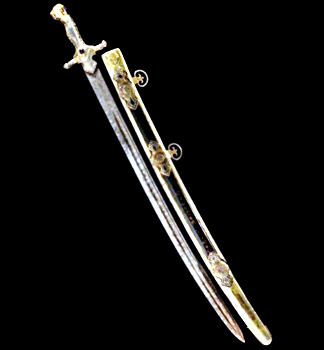 Among the several evidences available to prove that civilisation in ancient India had reached a very high stage of development is the record of great wars in the epics of the land. The records of pre-Aryan and Aryan periods are a glowing testimony to this fact. During these periods large-scale movements of humanity took place frequently necessitating the establishment of the supremacy by one people over another. This gave an impetus to the development of the science of warfare. Accounts of battles contained in the epics of Ramayana and Mahabharata show that the art of war was given high priority in all matters of state. Progress made in metallurgy during the Vedic age further revolutionised the art of war as a large number of weapons came to be made of these metals. Further, the Rig Veda provides interesting details of the political life and thought during the Vedic period. The king representing the will of the people held the main command of the army.
Among the several evidences available to prove that civilisation in ancient India had reached a very high stage of development is the record of great wars in the epics of the land. The records of pre-Aryan and Aryan periods are a glowing testimony to this fact. During these periods large-scale movements of humanity took place frequently necessitating the establishment of the supremacy by one people over another. This gave an impetus to the development of the science of warfare. Accounts of battles contained in the epics of Ramayana and Mahabharata show that the art of war was given high priority in all matters of state. Progress made in metallurgy during the Vedic age further revolutionised the art of war as a large number of weapons came to be made of these metals. Further, the Rig Veda provides interesting details of the political life and thought during the Vedic period. The king representing the will of the people held the main command of the army.
In the ancient times, battles were fought much in the same manner as at present. Impassable defence works and other obstacles were erected to stop the enemy`s advance. After sacrificial offerings to the ruling deity, the army advanced and took up battle positions. Martial music was played and the soldiers marched into battle accompanied by drums and trumpets. The chariots were vehicles of prestige and they led the vanguard in their spectacular array. The foot soldiers fought in masses of close formation. At that age, the army consisted only of chariots and infantry. The elephants came at a later date. The warrior was protected by a brazen coat of mail, hand-guards and helmet. The bow and arrow was the principal weapon of attack besides the spear, sword, dagger, mace, sling and axe.
The arms of the early period display an astonishing standard of perfection as seen from the excavations at Sanchi, Udayagiri, Mohenjodaro and Harappa. The great epics of Ramayana and Mahabharata and the Indian Puranas give some more details of the science of warfare as evinced in the battle formations, their everyday changes, use of a large number of weapons, vehicles and animals, employment of feints, war-cries, battle songs and a host of other means when huge scale fighting is taking place.
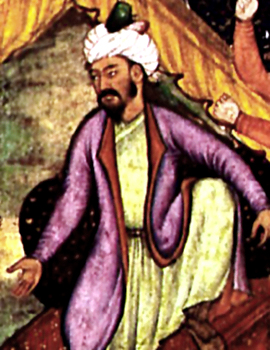 In the ancient era, the state was organised on a feudal basis. The constant wars brought cohesion, unity and organisation in the social system. Kingship was thus evolved as a natural phenomenon. There were powerful chiefs, nobles and corporations of fighting men from whom the king derived his strength. The king was considered as the fountain-head of the social system and all laws emanated from him and bore his authority. Under Chandragupta Maurya, Central Asian invaders like the Huns, who in their days had razed and plundered a major portion of the known civilised world, were to stand checked.
In the ancient era, the state was organised on a feudal basis. The constant wars brought cohesion, unity and organisation in the social system. Kingship was thus evolved as a natural phenomenon. There were powerful chiefs, nobles and corporations of fighting men from whom the king derived his strength. The king was considered as the fountain-head of the social system and all laws emanated from him and bore his authority. Under Chandragupta Maurya, Central Asian invaders like the Huns, who in their days had razed and plundered a major portion of the known civilised world, were to stand checked.
Indian Army during Medieval Period
When the Arabs, followers of the Muslim faith inspired by their new religious and military enthusiasm and emerging from their desert fastnesses, started exploring the East a new danger threatened the small kingdoms warring against each other. Their methods were new to the Indians. The Muslim rulers had a superior force in quality, equipment, training and above all morale which has from times immemorial paid ample dividends in battle. This first inroad of the Muslims and their spectacular success should not be taken as an example of their military superiority in any way. One main cause of the success of the Muslims was their reliance on cavalry. Mahmud`s expedition to Somnath is one of the greatest feats of military adventure in mediaeval Indian history.
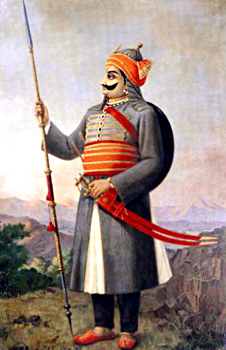 Babur laid the foundation of the Mughal Empire that was to be consolidated by this grandson - Akbar. Akbar is widely considered the greatest of the Mughal emperors. He took two decades to consolidate and bring parts of northern and central India into his realm. During his reign he reduced external military threats from the Afghans, solidified his rule by pursuing diplomacy with the powerful Rajputs. It was during his reign that Maharana Pratap Singh (1540- 1597), a Rajput ruler of Mewar, which was a state in north-western India, showed his mettle. The Maharana never accepted Akbar as ruler of India, and fought Akbar all his life. After Shah Jahan, however, the Mughal Dynasty had begun to crumble and various Princely States and smaller kingdoms began to assert themselves in various fields. The last of the Mughals was Aurangzeb. During his fifty-year reign, the empire reached its utmost physical limit but also witnessed the unmistakable symptoms of decline. Mughal rule prevailed over India for 300 years, fusing the country in many diverse fields like the arts, craft, music, architecture, literature and culture.
Babur laid the foundation of the Mughal Empire that was to be consolidated by this grandson - Akbar. Akbar is widely considered the greatest of the Mughal emperors. He took two decades to consolidate and bring parts of northern and central India into his realm. During his reign he reduced external military threats from the Afghans, solidified his rule by pursuing diplomacy with the powerful Rajputs. It was during his reign that Maharana Pratap Singh (1540- 1597), a Rajput ruler of Mewar, which was a state in north-western India, showed his mettle. The Maharana never accepted Akbar as ruler of India, and fought Akbar all his life. After Shah Jahan, however, the Mughal Dynasty had begun to crumble and various Princely States and smaller kingdoms began to assert themselves in various fields. The last of the Mughals was Aurangzeb. During his fifty-year reign, the empire reached its utmost physical limit but also witnessed the unmistakable symptoms of decline. Mughal rule prevailed over India for 300 years, fusing the country in many diverse fields like the arts, craft, music, architecture, literature and culture.
During the medieval period, the recruitment of cavalry followed the `Silidari` system whereby the volunteer cavalry soldier provided his own horse and equipment in return for a grant from the government. Even under Aurangzeb, the mansabdari and Silidari systems were fully stretched not only by the Mughal Emperor but also by some State Forces, particularly by the Maratha military chieftain Chhatrapati Shivaji. He had thoroughly studied the strengths and weaknesses of the Mughals and tempered his diplomacy, military doctrine, organisation and tactics to capitalise on the latter`s weakness. During the second half of the seventeenth century the Mughal Empire declined rapidly. The Marathas under Shivaji rose against the Muslim principality of Bijapur and established an independent principality there. Nevertheless, for internal empire - building and keeping outlying principalities in line, this system worked, but the later Mughals sold their inheritance over a period of time to the European trading firms, like the British East India Company and thus became weaker in all spheres including the military.
Indian Army during British Period
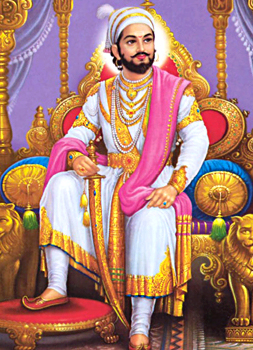 The modern Indian Army dates back to the early sixteenth century when Europeans, like the French, Dutch, Portuguese and British, established in India as traders. In 1600 the East India Company was formed to coordinate all British trading activities. The Mughal Empire, being at its zenith, did not consider these locally recruited and foreign military units to be any threat to its political, military and economic power. In 1640 AD the British East India Company founded its first fortified post Fort Saint George which soon became its headquarters. Eleven years later, in 1651, they set up another post which they later fortified, fearing Mughal threat, and named it Fort William.
The modern Indian Army dates back to the early sixteenth century when Europeans, like the French, Dutch, Portuguese and British, established in India as traders. In 1600 the East India Company was formed to coordinate all British trading activities. The Mughal Empire, being at its zenith, did not consider these locally recruited and foreign military units to be any threat to its political, military and economic power. In 1640 AD the British East India Company founded its first fortified post Fort Saint George which soon became its headquarters. Eleven years later, in 1651, they set up another post which they later fortified, fearing Mughal threat, and named it Fort William.
In 1662 the British received Bombay from the Portuguese. British troops arrived in Bombay in 1665, but it was only in 1668 when Bombay was formally handed over to the Company. In 1757, the reorganisation of the Indian troops into regular, organised battalions was entrusted by Major Lawrence to Robert Clive. Thus came into creation the first regular Indian infantry battalions, each with an establishment of one British captain, two lieutenants, several British sergeants, 42 Indian non commissioned officers and 820 Indian ranks and file. In 1759 Bombay Garrison`s Sepoy Companies were re-organised. In 1768 the first two regular Sepoy Battalions were formed, with a third in 1769 and a fourth in 1770. The beginning of eighteenth century also saw the rise of Sikhs in Punjab and the Rajputs of Rajputana. Having established themselves substantially by now, the Europeans started increasing their influence with the princely States and often resorted to war and intrigue against them. The British East India Company had a remarkable organisation. It built up its own Army, composed of European adventurers and native troops, under English Commanders.
Indian Army after Independence
Slowly and gradually the concept of nation came into existence. It implies a group of people that shares similar culture, language and ethnicity often possessing an independent government. After the independence of the country, the partition came into effect on 15th of August 1947. At the time of independence the old Indian Army stood divided between Pakistan and India. The active strength of the Army along with countrywide movable and immovable assets was shared under a complicated scheme, supervised by a British presence in the form of a Supreme Headquarters.
Interestingly, the military organisation of Indian Army after the independence of the country was not much different from that of British period. Once the recruitment process is over in the Indian Army, the candidate needs to go through a basic training period. At present, in Indian Army there are four kinds of forces operating and these are Regular Army, the Army Reserve, the Territorial Army and the National Cadet Corps.




















